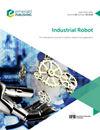一种非结构化环境下移动机器人导航的混合避障方法
IF 2.5
4区 计算机科学
Q3 ENGINEERING, INDUSTRIAL
Industrial Robot-The International Journal of Robotics Research and Application
Pub Date : 2022-07-12
DOI:10.1108/ir-04-2022-0102
引用次数: 3
摘要
目的轮式移动机器人(WMR)是应用最广泛的机器人。避开非结构化环境中的障碍物,特别是行人等动态障碍物,是WMR面临的严峻挑战。本文旨在提出一种混合避障方法,该方法将知情快速探索随机树*算法与三维(3D)目标检测方法和模型预测控制器(MPC)相结合,对非结构化环境下的WMR进行障碍物感知、无碰撞路径规划和避障。设计/方法/方法在给定参考方向和速度的情况下,根据三维目标检测结果,采用参数化椭圆表示障碍物扩展边界,规划无碰撞参考路径。然后,作者建立了一个模型预测控制,通过结合机器人与障碍物之间的距离来跟踪无碰撞参考路径。该框架是WMR的一种无映射方法。作者展示了一个移动机器人在室内拥挤的障碍物环境中避障的实验结果,比如椅子和行人。结果表明,所提出的混合避障方法能够满足移动机器人在非结构化环境中的应用需求。原创性/价值在本研究中,以速度为参数,采用参数椭圆表示障碍物所占的面积。因此,在规划阶段可以考虑动态障碍物的运动方向和位置,提高了避障成功率。此外,在MPC优化函数中增加了障碍物与机器人之间的距离,保证了机器人与障碍物之间的安全距离。本文章由计算机程序翻译,如有差异,请以英文原文为准。
A hybrid obstacle avoidance method for mobile robot navigation in unstructured environment
Purpose
Wheeled mobile robots (WMR) are the most widely used robots. Avoiding obstacles in unstructured environments, especially dynamic obstacles such as pedestrians, is a serious challenge for WMR. This paper aims to present a hybrid obstacle avoidance method that combines an informed-rapidly exploring random tree* algorithm with a three-dimensional (3D)-object detection approach and model prediction controller (MPC) to conduct obstacle perception, collision-free path planning and obstacle avoidance for WMR in unstructured environments.
Design/methodology/approach
Given a reference orientation and speed, the hybrid method uses parametric ellipses to represent obstacle expansion boundaries based on the 3D target detection results, and a collision-free reference path is planned. Then, the authors build on a model predictive control for tracking the collision-free reference path by incorporating the distance between the robot and obstacles. The proposed framework is a mapless method for WMR.
Findings
The authors present experimental results with a mobile robot for obstacle avoidance in indoor environments crowded with obstacles, such as chairs and pedestrians. The results show that the proposed hybrid obstacle avoidance method can satisfy the application requirements of mobile robots in unstructured environments.
Originality/value
In this study, the parameter ellipse is used to represent the area occupied by the obstacle, which takes the velocity as the parameter. Therefore, the motion direction and position of dynamic obstacles can be considered in the planning stage, which enhances the success rate of obstacle avoidance. In addition, the distance between the obstacle and robot is increased in the MPC optimization function to ensure a safe distance between the robot and the obstacle.
求助全文
通过发布文献求助,成功后即可免费获取论文全文。
去求助
来源期刊
CiteScore
4.50
自引率
16.70%
发文量
86
审稿时长
5.7 months
期刊介绍:
Industrial Robot publishes peer reviewed research articles, technology reviews and specially commissioned case studies. Each issue includes high quality content covering all aspects of robotic technology, and reflecting the most interesting and strategically important research and development activities from around the world.
The journal’s policy of not publishing work that has only been tested in simulation means that only the very best and most practical research articles are included. This ensures that the material that is published has real relevance and value for commercial manufacturing and research organizations. Industrial Robot''s coverage includes, but is not restricted to:
Automatic assembly
Flexible manufacturing
Programming optimisation
Simulation and offline programming
Service robots
Autonomous robots
Swarm intelligence
Humanoid robots
Prosthetics and exoskeletons
Machine intelligence
Military robots
Underwater and aerial robots
Cooperative robots
Flexible grippers and tactile sensing
Robot vision
Teleoperation
Mobile robots
Search and rescue robots
Robot welding
Collision avoidance
Robotic machining
Surgical robots
Call for Papers 2020
AI for Autonomous Unmanned Systems
Agricultural Robot
Brain-Computer Interfaces for Human-Robot Interaction
Cooperative Robots
Robots for Environmental Monitoring
Rehabilitation Robots
Wearable Robotics/Exoskeletons.

 求助内容:
求助内容: 应助结果提醒方式:
应助结果提醒方式:


